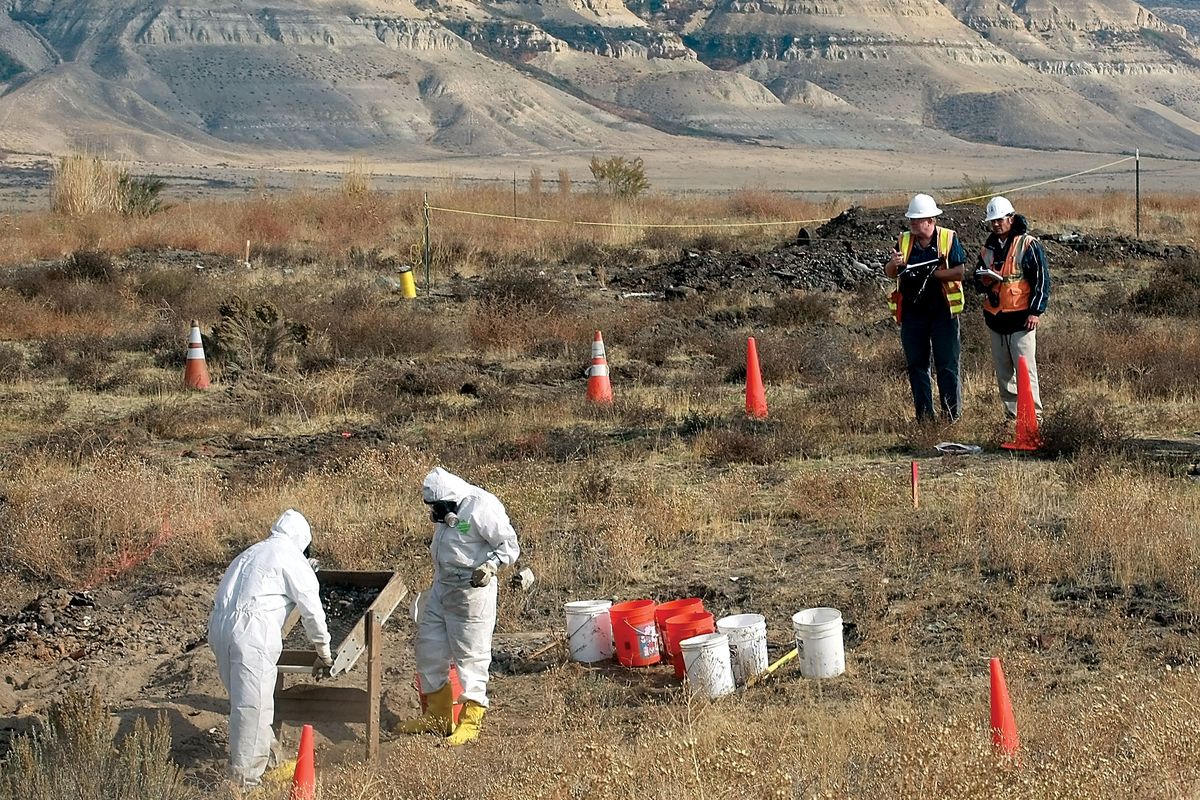Excavators unearthing a bottled-up history
Hanford dump site contains clues to workers’ lifestyles

RICHLAND – A glass beer bottle with a faded label that says “brewed in Walla Walla.” Two children’s marbles. A 1938 Buick Roadmaster hubcap. Heavy white ceramic shaving mugs.
And more beer bottles – lots and lots of beer bottles.
That’s just a sampling of the items that have been unearthed from pits at Hanford where trash generated by the tens of thousands of workers who came to the nuclear reservation during World War II was buried.
Archaeologists are sorting through what those early Hanford workers and their families threw away at the atomic boom town, seeing if what they find can tell more of the story of the Manhattan Project.
“This is a little piece of the puzzle we are trying to add to it,” said Brian Smith, archaeologist and owner of Brian F. Smith and Associates of San Diego.
Interviews over the years have collected information directly from the people who moved to the barren Eastern Washington desert during the war for a secret project. Only a few scientists and some engineers clever enough to piece together information knew that they were building an industrial complex to produce plutonium in the world’s first production-size nuclear reactors.
The site produced plutonium for the world’s first atomic explosion and the atomic bomb dropped on Nagasaki, Japan, helping to end the war.
But the trash the workers left behind may provide more information about the lives of the site’s workers.
“It’s an interesting picture because a lot of different people came here from around the country,” Smith said.
Speculation of what might be found has included hopes of decorative or luxury goods that show cultural origins or family and religious values, according to the archaeological plan. Or artifacts might show how workers, many of them men too old to serve as soldiers, coped with a lonely existence using alcohol or gambling. And certainly a story might unfold about what items were widely available at construction camp stores.
The Hanford Engineer Works constructed barracks, prefabricated huts and trailer parks there between April 1943 and 1944, Douglas Wilson of the National Park Service wrote in his research design for the archaeological project.
Each men’s barracks had 100 sleeping rooms for 191 workers. Separate women’s barracks had larger rooms and were surrounded with barbed wire and signs to restrict men’s access.
The huts, similar to Quonset huts, housed more than 10,000 workers, with 10 to 20 workers to a hut.
The construction camp also claimed bragging rights for the world’s largest trailer park. There were 3,639 trailer lots in three different areas, mostly for workers with families.
The construction camp was segregated, with a separate area for blacks that included 76 trailer lots and men’s and women’s barracks.
“It is probably not accidental that the system that segregated the African-American population also placed it closest to the landfill site,” Wilson wrote.
Originally workers had only the stores that served the tiny town of Hanford, but as the work force grew, more services were added, including drug stores, a beauty parlor, recreation halls and a canteen selling tobacco, magazines and candy.
“At no time were luxury items available in quantity at the camp,” Wilson wrote.
Much of what has been unearthed this fall from the waste pits appears to have been sold in the limited shops that supplied workers and their families.
Many medicine jars were collected – Alka Seltzer bottles, cod liver oil bottles and cough syrup bottles, like a Creomulsion bottle with raised letters noting “for coughs due to colds.” A Vicks VapoRub bottle smelled of menthol more than 60 years later.
Frugal wartime ways prevented some materials from being sent to the pits. Tin cans, scrap metal and rubber likely were collected for the war effort.
“The glass bottles seem to persist,” said archaeologist Sara Clowery.
The bottles include many beer, whiskey and Coca Cola bottles. But even the Coca Cola bottles are interesting to archaeologists because stamped on their bottoms are their origins: Yakima, Bend, Ore., and other locations across the nation.
Other debris appears to have come from the eight large mess halls that fed the workers. Multiple bent pieces of flatware have been unearthed with the same pattern. The burial grounds also have large bones that appear to be from the meat cooked in the halls.
But what’s interesting for archaeologists are items that appear to have come from outside the camp with the workers.
An archaeologist plucked a tiny dark blue bottle from the debris that likely once held perfume.
A wine bottle from Jeres, Spain, was unearthed. Another archaeologist had roughly pieced together a hand-glazed painted teapot with “Made in Japan” on its bottom.
“I like to see anything personal,” Clowery said.
She also has been intrigued by the many small bottles with a tiny lip inside – apparently ink bottles. The lip held a pool of ink near the top.
Excavation of the burial pits is about half completed and Federal Engineers and Constructors, a subcontractor for Washington Closure Hanford, plans to finish by the end of the month.
The subcontractor digs up a foot of soil and debris at a time from an area about 5 feet wide and 10 feet long. The material is dumped in a pile where laborers rake it onto a piece of plywood. Archaeologists point out anything they’d like to examine or save.
About 10 percent of the debris is sifted to find small items like buttons.
Each item is washed, often scrubbed with a toothbrush, and then brought to the archaeological lab in a portable office nearby. The artifacts are photographed and entered into a database. One of each different item is saved, but duplicates will be disposed of at Hanford.
Any stories archaeologists can pull from the artifacts will be included in a social history expected to be finished in early 2010.